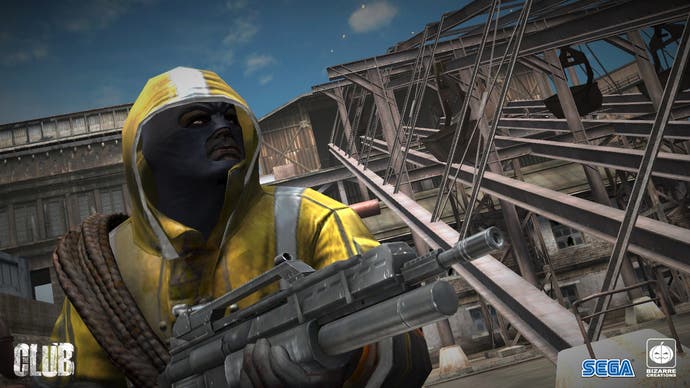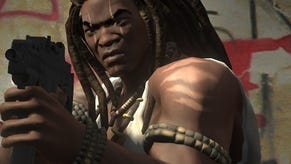The Club
Bizarre's grand opening.
During the latest presentation of The Club, SEGA refers to it as 'gladiators with guns', which is a pretty reasonable description. So is 'a third-person shooter with a mature theme and a pick-up-and-play sensibility', which is used later in the presentation. Neither description does justice to the range and diversity of influences on the game though. The key influence is, of course, Project Gotham (as you'll know if you read Eurogamer's E3 preview). Specifically, the game's creator, Bizarre Creations, wants to do for the shoot-'em-up what its Gotham series did for the racing genre. The Club is an attempt to impose a unique scoring system and innovative game modes upon the shoot-'em-up genre to produce something fresh and novel. But still, that's selling the game short. There's a whole load of other unlikely influences, ranging from TimeSplitters to Tony Hawk's by way of the odd beat-'em-up, a bit of Manhunt and back to SEGA's own OutTrigger.
Although the high concept - Project Gotham for guns - has been knocking around Bizarre Creations for ages, the game's been in actual development for 18 months, by a 49-strong team with the likes of Fur Fighters and Project Gotham on their CVs. Nevertheless, Bizarre hasn't been afraid to use outside talent: 2000AD's Gordon Rennie's been drafted in to draft the back-story and character biographies; John Wallin came in to provide the concept art for the game's environments (after he did such a good job on Gears of War); and the game's guns have been designed by George Hull, who did a similar job on The Matrix and V for Vendetta.

The back-story in question revolves around The Club: "The most secretive and exclusive organisation in the world. The deadliest game on the planet." The premise is that some of the world's most powerful people sponsor participants in The Club's deadly bouts for nothing more than their own idle amusement. And the world's most powerful people are so powerful that Bizarre has retconned the real world, casting The Club as the shadowy organisation behind many key moments in history. Thus real world conflicts are actually the outcome of the world's richest and most influential leaders squabbling and arguing over disagreements and gambling debts arising out of the game's secretive blood sport. The American Act of Independence, the Gulf War and so on are all are a testament to the vast scale of money and influence riding on the outcome of Club fights.
The playable characters in question, are, of course, the participants in that blood sport, and they demonstrate the influence of beat-'em ups on the game's design. Indeed, during the presentation a SEGA spokesman refers to the game as "a beat-'em up with guns", and reckons that the game combines the "diversity of a fighting game with the intensity of a shooter". Which is another reasonable description of the game. There were originally 12 characters before they were whittled down to reach the final eight. That final eight is not, as you might expect, the eight characters who inspired the broadest agreement in testing, but actually those characters who polarised opinion and provoked the strongest reactions. That's because Bizarre doesn't want the sorts of characters who inspire bland consensus. Instead they want characters that you can learn to love to hate, generating the sorts of gaming rivalries that have been going ever since E. Honda handslapped his way around Zangief's spinning piledriver.

For example, there's Renwick, who bears an uncanny likeness to Ving Rhames and who, to judge by his NYPD body armour, is some kind of ex-cop (further evidence is provided by his catchphrase at the start of sessions: "I'm going to infiltrate The Club and destroy it from within"). Other characters include a pouting Japanese Ura-Harajuku youth and a Russian assassin, kidnapped from a forest, who comes complete with ferrets hanging from his waist. Each one is obviously distinguished from each other by their appearance, but also by a range of underlying attributes that will become obvious when you play with them - stamina, speed, and favouring different weapons.
The environments reveal a bit more about the back-story, and highlight, again, the influence of Project Gotham. There are eight locations, spread out around the world. As in Project Gotham, however, each environment is home to multiple different layouts so there will actually be around 50 or 60 specific level designs, each of which will be further distinguished by different weather conditions or different times. The eight environments in question tell you a bit about the type of people who participate in the high stakes gambling on offer in The Club: there's prison cells, a bunker, a war-torn city, a manor house, and even a disused ocean liner. The Steel Mill that provides the setting for SEGA's presentation is, for example, owned by a powerful movie director: any fears that the locals might have are kept in check by the story that it's being used as the set of a particularly violent movie.

Once the action actually starts, the first thing you notice is that the game looks pretty sweet. There's a really neat blur effect when your character sprints, for example, and the character animations really stand out. The next thing you notice is that this game is not about stealth. No sir. It's about 'relentless pace and skill' according to SEGA. Which seems to translate as not stopping moving, blowing loads of stuff up really quickly and stylishly, with lots of explosions, and shaking cameras and so on. Controls are simple and designed to facilitate a streamlined fighting experience: smashing through doors or vaulting over obstacles are context-sensitive actions, and melee attacks will essentially be auto-targeting (a la Gears of War). Holding the left trigger zooms in, but what you gain in accuracy you lose in speed.
And then you notice the Tony Hawk's influence. The main aim of the game is to beat target scores, or your friends, by racking up points. And you rack up points by killing enemies and stringing those kills into combinations. As we were shown back at E3, extra points are awarded on the basis of hit locations (hitting enemies in the head, for example), or style (rolling round corners before hitting your enemy in the head, for example), or for weapon-specific reasons (rolling around a corner and then hitting your enemy in the head while using your shotgun up close, for example). It's also possible to gain bonuses by hitting enemies with ricochet shots, or by seeing them off with the last bullet in your clip (in fact the game's rhythm is partly determined by your need to balance reload times with the appearance of enemies). And there are special 'skullshot' symbols that you can shoot to keep your combo multiplier going.

And that's why it's like Tony Hawk's (or, indeed Chilli Con Carnage). Because the real object of the game is to chain together lengthy combos and to replay levels until you've mastered their particular nuances. The enemy AI isn't especially bright, but that's not the point here: it's entirely possible to learn the position of your opponents and take advantage of that on your next play through, and that's precisely the point. (As to what motivates these cannon fodder to turn up to a job with few prospects of seeing the end of it, well apparently they're drawn from the ranks of criminal detritus and lowlifes looking for a promotion, and they don't know that the odds are stacked against them.)
The occasional roving enemies throw in an element of unpredictability, but although it's possible to be killed (as, indeed, SEGA's producers were on a couple of occasions), the general balance of health pick-ups and damage done by enemies tends to favour the player. Consequently, it's fairly easy to get to the end of any given level: the real challenge is to score enough points to unlock the next one. That might be a fairly linear, tight level, with the occasional multiple route, as in the demonstration, or it might be an open arena, or simply a survival challenge involving staying alive for as long as possible. But each level takes only two to five minutes to play through - so the game isn't punitive if you miss the start of a particular combo and want to begin again, or if you want to pass the controller to one of your friends to see if they can beat your score. Or you could just participate in one of the game's multiple multiplayer modes, though SEGA remains coy about those for the moment.
And so that's The Club. It's enormously promising. And it's a vibrantly depicted arcadey arena third-person shooter, with a snuff movie ethic and beat-'em-up sensibility, in which you stack up improbable combo-chains to gain kudos from your friends and cause big explosions. Which is the best description I can come up with, anyway.


